As part of our Bachelor of Science design project, we (J. de Bruijckere, R. Smit and L. Valk) have developed a mechanical, electrical and software design for a lightweight, mobile exploration robot that employs the half-circle leg morphology. The morphology is based on TU Delft’s Zebro robot, which in turn is based on the RHex project, developed by a group of universities led by the Kod*Lab. The Zebro Light reduces the weight of the original Zebro from 7.5 to 3.2 kg, while also reducing the top surface area by 50%.
The robot’s structure is designed to be lightweight, without compromising its robustness. The electronics and software are designed to make each leg follow specified reference trajectories, by actively controlling motor position using feedback from rotary encoders. A prototype of the design has been constructed and tested, demonstrating a stable walking behavior. Adaptability of the mechanical design and high performance of the on-board computer allow this design to be used as a versatile platform for research on walking exploration robots. More details can be found in this short paper.
The Zebro Light is able to cross various types of terrain, as shown in the figures above and below. The robot has been demonstrated at the NASA exhibition “A Human Adventure”, in Utrecht, the Netherlands.
Video
Mechanical structure
The robot’s frame consists of six identical motor units held together by two polycarbonate plates. This results in a lightweight yet robust construction, as shown in the figures below.
Electronics
The position of each motor is actively controlled in order to make each leg follow reference trajectories that result in a stable gait. An overview of the system is given below. The on-board computer is the Beaglebone with a custom cape design to interface with the incremental motor encoders. The robot uses three Dimension Engineering Sabertooth 2×12 drivers to power all six Maxon Motors.
About the designers
The Zebro Light has been designed and prototyped by J. de Bruijckere, R. Smit and L. Valk. They are three mechanical engineering students at Delft University of Technology (the Netherlands), who developed this robot as part of their final Bachelor of Science design project.
References
[1] Saranli, U., et al. ”RHex: A simple and highly mobile hexapod robot.” The International Journal of Robotics Research 20.7 (2001): 616-631.
[2] Kersbergen, B., et al. ”Optimal gait switching for legged locomotion.” Intelligent Robots and Systems (IROS), 2011 IEEE/RSJ International Conference on. IEEE, 2011.
[3] Moore, E. Z., et al. ”Reliable stair climbing in the simple hexapod ’RHex’.” Robotics and Automation, 2002. Proceedings. ICRA’02. IEEE International Conference on. Vol. 3. IEEE, 2002.
[4] Molloy, D. ”Getting started with the Beaglebone.” Available: derekmolloy.ie.

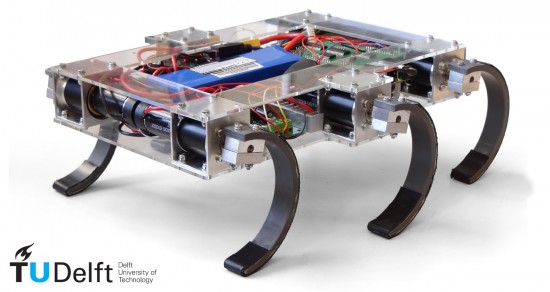
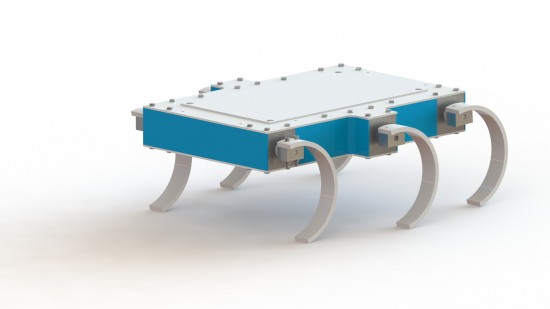
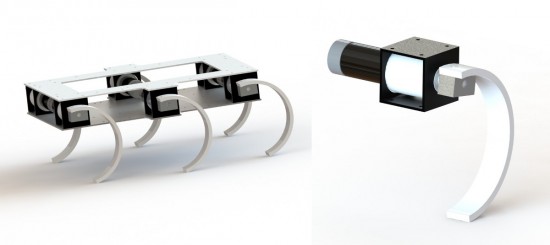
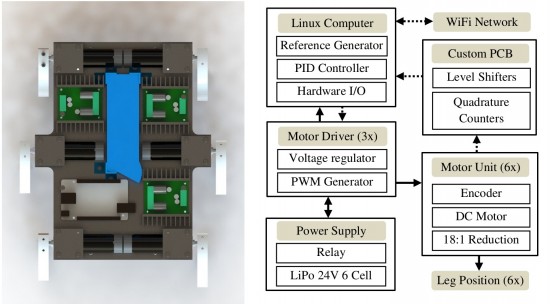
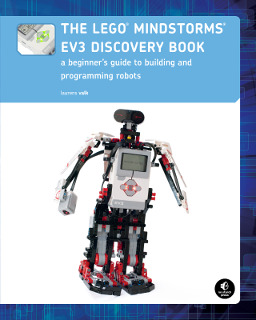
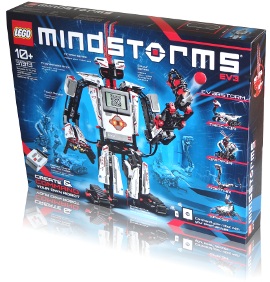
Hi Laurens,
I like this robot very much. Have you considered to recreate it with lego and two NXT’s?
Aswin
Hi Aswin,
Thanks. It’s on my to do list 🙂
I’ll probably have to use NXT motors/ Large Ev3 motors because of the torque required, but their shape will unfortunately require a rather asymmetrical construction.
Laurens
Hi Laurens,
Today I visited NASA – A Human Adventure, which features your Zebro Light robot. Very cool. My six year old son loved it as well! Seems to me a great project to build at home / at school. To make it more affordable, most likely other (i.e. cheaper) components need to be used. Have your ideas of using LEGO or RaspberryPi evolved since the last post?
Regards,
Michael
Hi Michael,
Thanks for your comment. Glad to hear you liked it. Did they have a replacement robot in the ‘Mars Area’ now that the original robot has returned to TU Delft?
The main cost (maybe 80%) is due to the high precision motors that we used. I’d like to try this with NXT/EV3 motors but unfortunately I haven’t had any time to work on it.
Best,
Laurens
Yes, they had a four legged robot on display. Would you like a picture mailed?
Could you elaborate a bit on why these high precision motors were used, compared to cheaper ones?
Yes, please do email the picture – thanks! My email address is on the about/contact page.
The robot was designed to be used for further research (by others) at TU Delft, including for the development of new walking algorithms.
I think that much less precision and torque would still be fine, depending on the robot’s application. This robot can lift more than its own weight, but that won’t always be necessary,
Alright… And what were the design considerations to use a Beaglebone instead of the cheaper RaspberryPi?
Though we used the original Beaglebone last year, the new Beaglebone Black is only $45. (The Raspberry Pi is $35.)
The BBB has more hardware I/O capabilities, such as several UART, I2C, PWM and many GPIO pins while the RPi has just a few. We used several of these interfaces to control the motors and read the motor encoders. The remaining I/O can be used for additional features.
I need to be more proactive to find out what’s going on in our vaiorus branch libraries in the city. I imagine I am missing some great talks. Even if you pick up one tip you can use, the time is valuable.
I saw it in Utrecht, in a thing that simulates Mars.
I like your robotic designs.My favorite EV3 Robot is your LAVA-R3X.I want your
EV3 (home set) robots’ build instructions.
Can you buy some? If possible where?
I like the robot ‘s only one feature that it can face any obstacle comparable of its own size in its path